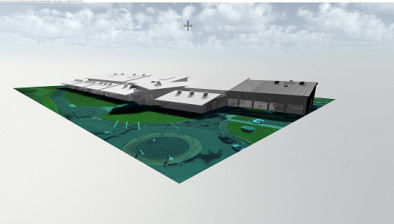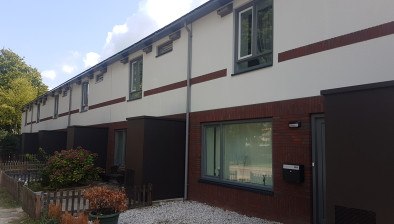Consortium visualises augmented reality future for construction industry
 The construction sector could be on the verge of a virtual revolution thanks to new augmented and virtual reality (AR and VR) technology created by a cohort of organisations.
The construction sector could be on the verge of a virtual revolution thanks to new augmented and virtual reality (AR and VR) technology created by a cohort of organisations.
The consortium, which includes the University of Strathclyde’s Advanced Forming Research Centre (AFRC) and the Advanced Manufacturing Research Centre with Boeing (AMRC) in Sheffield, has been working with Glasgow-based design visualisation company Soluis Group and modular building designer and manufacturer Carbon Dynamic to build a demonstrator for the use of AR and VR in the construction industry.
The technology was first trialled on a 2.2-metre plasterboard wall which, when viewed with a Microsoft HoloLens, showed a 3D rendering of the plumbing and wiring behind the façade.
The system can also be used to examine different wall parts to ensure there are no gaps in insulation before being sent to a construction site. This presents significant cost-cutting and time-saving opportunities, as well as the enhancement of quality assurance on modular construction projects.
 Speaking about the project, David Grant, partnership development leader at the AFRC, said: “This new technology has a role to play before, during and after construction of both domestic and commercial properties.
Speaking about the project, David Grant, partnership development leader at the AFRC, said: “This new technology has a role to play before, during and after construction of both domestic and commercial properties.
“Prior to work commencing on site, those involved in a construction project will be able to accurately visualise and walk through a building before the foundations are even dug, this will help in identifying any potential issues before they occur. It could also help during a build as contractors will be able to accurately see what’s behind walls and under floors, potentially leading to improved health and safety on sites as all guess work could be eliminated. Post construction it will help with remedial and retrofitting work – even years down the line – as all of the information relating to a building – from where electricity cables and pipe work are installed to the guarantees and instruction manuals for boilers, light fittings and showers will be accessible using this technology.”
He added: “Projects like this can inspire hearts and minds in the construction sector to accelerate their adoption of new technologies – the potential for AR and VR in the industry is vast. Of course, this is just the first phase; demonstrating what could be achieved if the right platform was developed as a standard for the industry – the tools still need to be created.
“What we have done is prove that the technology works and, with the necessary skills, the right kind of software applications can be developed. While there are bespoke programmes already available, there isn’t a platform everyone can use to push and pull information from AR and VR devices. This is the first step forward in addressing that gap.”
Chris Freeman, technical lead for augmented reality, at the AMRC with Boeing, added: “The AFRC was integral in laying the groundwork for the demonstrator, with thorough research and identifying the business drivers for introducing AR and VR capabilities. We’re hoping to do more in this area with our industrial partners, as more companies in the construction sector begin to realise the benefits these technologies can bring.”























